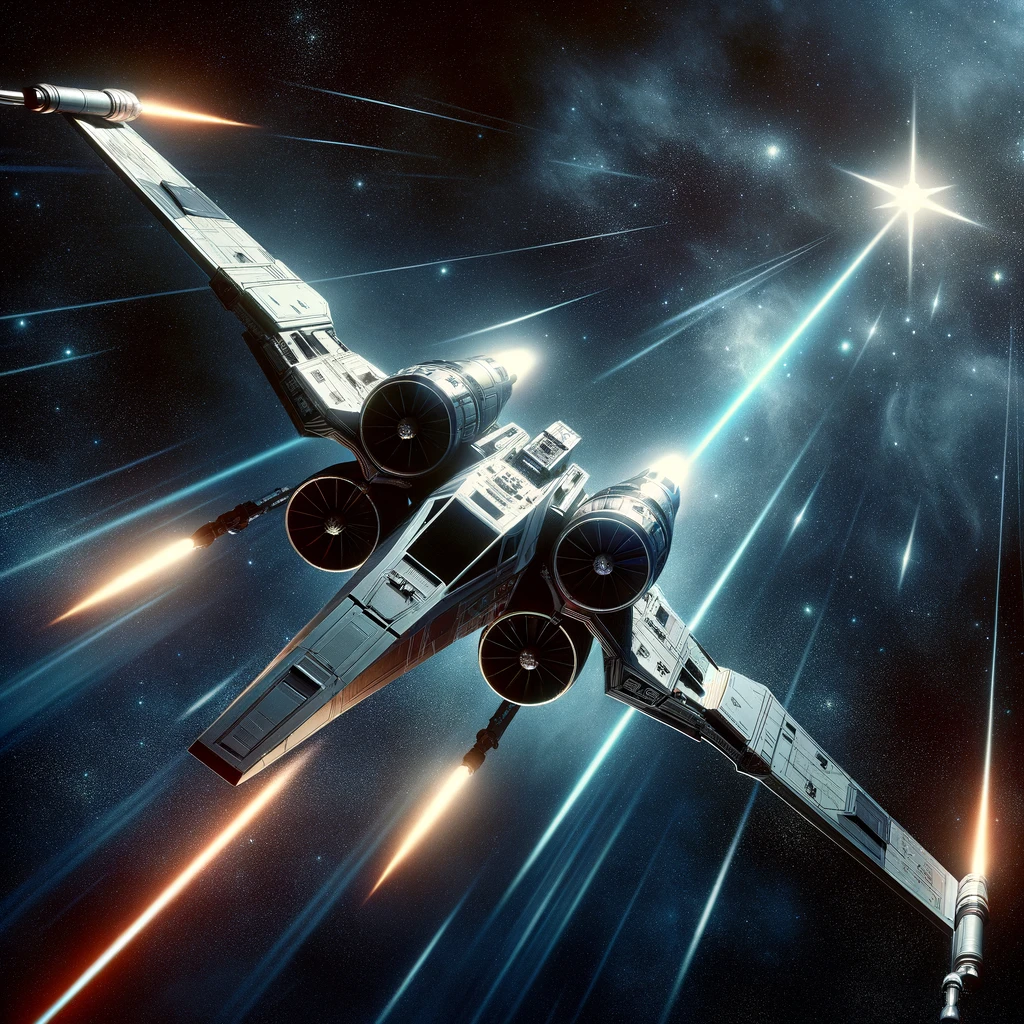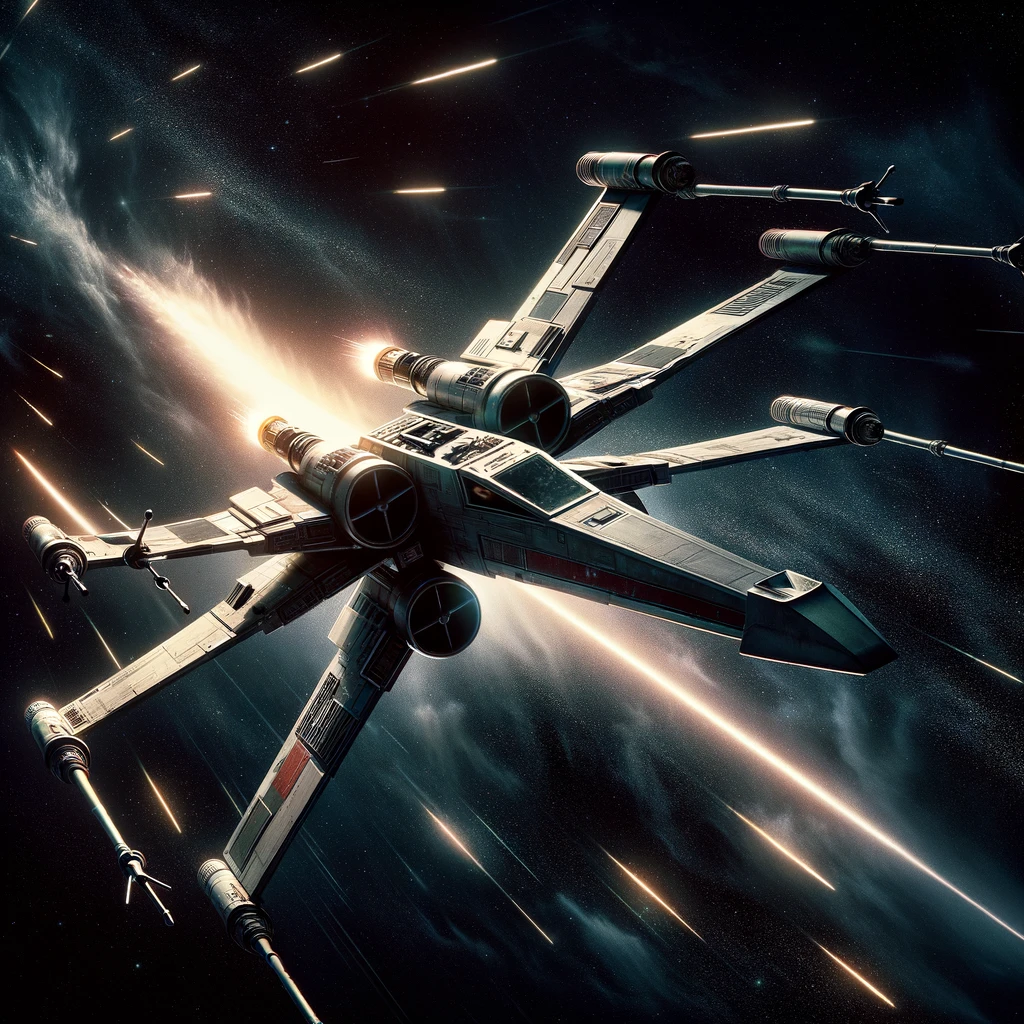Join us on an adventure, across the stars as we count down the ” 15 Most Legendary Star Wars Spaceships.” Every ship has its tale to tell and symbolizes events in the expansive world of “Star Wars.” From the nimble X Wings of the Rebellion to the presence of the Empire Star Destroyers, these vessels go beyond transportation—they are essential figures, with their own stories. Let’s delve into these spacecraft and how they have influenced an extraordinary galaxy.
Table of Contents
Millennium Falcon: The Heart of Star Wars
The Millennium Falcon is more, than a vessel; it plays a role as a character in the “Star Wars” series. With its design resembling a flying saucer and a cockpit jutting out to the side, the Falcon holds significance beyond its outer shell. Referred to as the ” spacecraft in the universe ” it showcases remarkable speed and maneuverability, largely due, to enhancements carried out by its different proprietors, notably Han Solo and Chewbacca.
Design and Features
The Millennium Falcon, a freighter of the YT 1300 model, may seem modest at a glance, even rundown. Yet its unique layout is intentionally effective combining speed, armaments, and stealth in a way that outshines bulkier vessels. With enabling, then light travel it has been pivotal, in evasive maneuvers and strategic engagements that have influenced numerous conflicts.
Iconic Moments
The Millennium Falcon plays a role, in scenes throughout the Star Wars movies. It first appeared in “Star Wars; Episode IV. A New Hope,” where it successfully rescued Princess Leia from the Death Star. The ship showcased its capabilities more when it maneuvered through an asteroid field in “The Empire Strikes Back ” and notably it fired the decisive shots that brought down the second Death Star in “Return of the Jedi.”
Legacy and Symbolism
For enthusiasts, the Millennium Falcon holds a place, as a symbol of the rebellion’s essence. It signifies the notion that appearances can be misleading and underestimating something or someone may lead to consequences—a recurring motif in the “Star Wars” galaxy. The spacecraft embodies notions of liberty, thrill, and the daring nature of its pilots.
Furthermore, the enduring popularity of the Millennium Falcon is evident in its presence throughout all three “Star Wars” trilogies, serving as a connection, between the characters and the newer generation. Fans continue to adore it for its appeal and dependability, much like its charming owner, Han Solo.

X-Wing Fighter: Symbol of Rebellion
The X-Wing Fighter is widely known as one of the easily recognizable spacecraft, in the “Star Wars” galaxy. It represents the essence of the Rebel Alliance through its structure and significant role in combat. This starship has emerged as a symbol of resistance against tyranny playing a part in important triumphs, against the Galactic Empire.
Design and Capabilities
The X-Wing starfighter is known for its ability to blend speed, power, and nimbleness effectively. Its unique design includes wings that split into an “X” shape during battle allowing for a range of firepower. With laser cannons, on each wing, the X Wing proves to be a contender in combat. Additionally, it comes equipped with proton torpedoes, a hyperdrive system, and a slot for a droid. Often occupied by R2 D2, in Luke Skywalkers X Wing. Which helps with navigation and maintenance tasks.
Notable Battles
The iconic moment, for the X Wing occurs in “Star Wars; Episode IV. A New Hope” during the Battle of Yavin. Luke Skywalker commands an X Wing to deliver the blow to the Death Star, marking a triumph for the Rebel Alliance. This event solidifies the X Wing’s importance as an asset in the rebellion’s arsenal and a symbol of hope for those under oppression. The X Wing’s capabilities are again highlighted in the Battle of Endor and across parts of the series emphasizing its enduring significance, in the ongoing struggle.
Legacy and Cultural Impact
The X Wing, from the “Star Wars” movies, has become more than a spacecraft on screen—it’s now a symbol ingrained in our culture. Its unique design has sparked ideas, for life aircraft and space exploration technologies. Fans love collecting X toys and models for their intricate details and the important role they play in the Star Wars storyline. Additionally seeing the X Wing featured in books, video games, and TV series reinforces its representation as a sign of strength and determination. Its enduring popularity ensures that it remains a central element of the “Star Wars” legacy, representing the heroism and courage of the characters who pilot it.

TIE Fighter: The Icon of the Empire
In the “Star Wars” universe the TIE Fighter is widely known for its howl and one-of-a-kind appearance, symbolizing the power and control of the Galactic Empire. With its Twin Ion Engine acronym, these spacecraft are a presence, in the franchise, showcasing the Empire’s strength and advanced technology.
Design and Features
TIE Fighters are famous, for their appearance, with prominent hexagonal solar panels on each side of a rounded cockpit. This distinctive design not only gives the TIE Fighter its shape but also plays a key role in its ability to move swiftly and nimbly during space combat. Despite this, these vessels forego shields and heavy armor in exchange for agility and speed aligning with the Empire’s preference for quantity over individual defense capabilities, in battle tactics.
Role in Galactic Conflicts
TIE Fighters are mainly employed to attack enemy vessels, in groups, using their agility and sheer quantity to overpower foes. They pose a challenge to the protagonists in the “Star Wars” narrative participating in confrontations with Rebel spacecraft. Memorable instances include their involvement in the Battle of Yavin and the Battle of Endor, where they were dispatched in numbers to protect the Death Stars. Their presence symbolizes the Empire’s quest for dominance and structure presenting a hindrance to the main characters, throughout the series.
Legacy and Symbolism
The TIE Fighters’ look and sound are more than famous; they bring to mind the oppressive vibe of the Empire. The ship’s visual and auditory elements have become recognized symbols representing dominance in various media beyond just the “Star Wars” movies. Within the series itself, the TIE Fighter stands out starkly against the Rebel ship’s rugged and individualized designs highlighting the Empire’s faceless conformity and ruthless efficiency.
Additionally, fans have embraced the TIE Fighter for its role in model building and simulation games, where players enjoy mastering its glass cannon” dynamics. Potent delicate. Its significance, in the storylines and unique design ensures that the TIE Fighter remains a component of the “Star Wars” galaxy embodying the shadow of Imperial influence.
Star Destroyer: The Dread of the Empire
In the “Star Wars” universe the Star Destroyer stands out as a representation of the Empire’s dominance. These colossal ships do not serve as vessels. Also symbolizes the empire’s strength and authority making a significant impact whenever they make an appearance, showcasing their capacity to exert control throughout the galaxy.
Design and Capabilities
In the universe of “Star Wars ” Star Destroyers stand out with their dagger-shaped appearance ranking high among the powerful capital ships. These vessels play roles such, as battleships, carriers, and command ships, within the Imperial fleet showcasing their versatility and importance. Their massive size allows them to carry a complement of smaller craft, such as TIE Fighters, and they are heavily armed with turbo lasers and ion cannons for both ship-to-ship combat and orbital bombardments.
Notable Engagements
Star Destroyers are commonly present, in battles within the “Star Wars” universe, frequently depicted as taking the lead in confrontations against Rebel factions. These massive vessels play a role, in blockades and invasions, leveraging their firepower and fighter units to bring entire planets under control. A memorable instance is seen at the beginning of “Star Wars; Episode IV. A New Hope,” where a Star Destroyer seizes Princess Leia’s vessel, the Tantive IV marking the start of the trilogy.
Legacy and Symbolism
The imposing sight of a Star Destroyer hovering above a planet holds significance, symbolizing the reaching control and dominance of the Empire. Their immense size and power serve as representations of rule, transcending their role as military vessels to embody symbols of oppression and authority.
Moreover, Star Destroyers have left a lasting impression, on culture, emerging as symbols within the realm of “Star Wars” merchandise. Fans widely embrace models, toys, and crafted replicas, highlighting their significance not as plot devices but, as emblems.
Slave 1: Boba Fett’s Formidable Vessel
Slave 1 is just as iconic and mysterious, as its pilot, the legendary bounty hunter Boba Fett. This special spacecraft not match the personality of its owner. Also distinguishes itself from the many other spaceships in the “Star Wars” galaxy, with its exceptional design and features.
Design and Features
The Slave 1 ship has a takeoff style that switches from vertical to while flying, making it visually impressive and easy to remember. Its design is both functional and distinctive, enabling maneuvers, in all directions, ideal for evading or chasing situations. With its arsenal of weapons like blaster cannons and seismic charges (known for their explosions in “Attack of the Clones”) Slave 1 proves to be a formidable vessel, in battles.
Notable Appearances
Slave 1 plays a role in important moments, across the movies. It makes its debut in “The Empire Strikes Back” when Boba Fett employs it to pursue and seize Han Solo’s Millennium Falcon delivering the Han Solo to Jabba the Hutt in “Return of the Jedi.” The ship’s abilities are again demonstrated in “Attack of the Clones” during the thrilling asteroid field pursuit, with Obi-Wan Kenobi showcasing its speed and firepower.
Legacy and Symbolism
Slave 1 is not just a tool in Boba Fett’s bounty hunting; it is a symbol of the fear and respect he commands across the galaxy. The ship’s design and armament reflect Fett’s own reputation as a relentless and well-equipped hunter. Its unique features and the memorable scenes it partakes in have turned it into a fan favorite, representing the darker, more mysterious side of the “Star Wars” universe.
Furthermore, Slave 1 has been immortalized through numerous toys and models, which are highly sought after by collectors. The ship’s distinct look and ties to one of the most revered characters in the “Star Wars” lore have cemented its place in the cultural fabric of the franchise.
Conclusion.
As we wrap up our journey through the 15 Star Wars ships it’s evident that each spacecraft is more than just a mode of transportation. They are components that enhance the storytelling of the “Star Wars” universe. These famous ships, including the Millennium Falcon and the formidable Death Star, have roles in the battles and thrilling escapades that shape this beloved saga. Their designs, capabilities, and the memorable moments they create contribute profoundly to the “Star Wars” legacy, making each ship a cherished symbol within the galaxy and beyond. Fans and newcomers alike continue to be captivated by these iconic vessels, ensuring their place in both cinematic history and the hearts of millions around the world.












